The benefits and harms of leeks for health: what is good and how to use it correctly
Leeks are not a very popular vegetable in Russia. However, in the West, this crop is grown and consumed everywhere and in large quantities. And it's not just the delicate and sweet taste of leeks.
He has the broadest spectrum properties useful for the body, used in dietetics, cosmetology and folk medicine.
The content of the article
Composition and properties
The highest concentration of useful vitamins and trace elements is concentrated in the upper parts of the onion stalk, so you should not get rid of it during cooking.
Some of the ingredients in leeks:
- B vitamins (B1, 2, 5, 6, 7, 9);
- vitamin A, C, PP, H, K, E;
- trace elements - iron, copper, manganese, zinc, boron, chromium, iodine;
- macronutrients - calcium, magnesium, phosphorus, potassium, sodium, silicon;
- linolenic and oleic acids;
- mono - and disaccharides;
- polyunsaturated Omega-3 and Omega-6;
- phytoncides;
- essential oils.
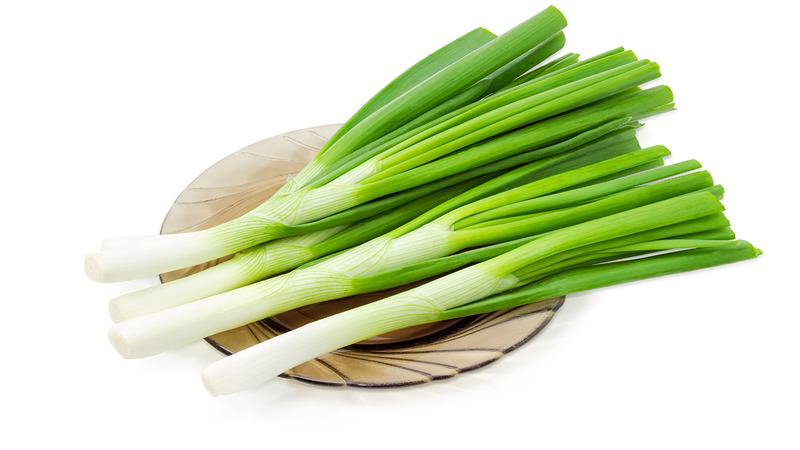
The nutritional value
Nutritional value of leeks per 100 g - 33 kcal. The content of substances necessary for the functioning of the body (per 100 g of product):
- proteins - 1.5 g;
- fats - 0.3 g;
- carbohydrates - 6.3 g;
- sucrose - 3.9 g;
- fiber - 1.8 g
Effects of leeks on the human body
The medicinal properties of the vegetable are extensive and well known.
Leeks have a pronounced therapeutic effect on the entire body, in particular:
- improves liver function;
- fights anemia;
- saturates the body with magnesium, thereby improving the protection of the nervous system from stress factors;
- normalizes pressure;
- increases sex drive, being a strong aphrodisiac;
- improves memory and concentration;
- strengthens teeth and bones;
- restores strength and gives a boost of vivacity;
- lowers blood cholesterol levels, thereby reducing the risk of developing atherosclerosis;
- maintains visual acuity and eye health.
Leeks are an effective remedy for slimming: it significantly speeds up metabolism and normalizes metabolic processes.
Leek for various diseases
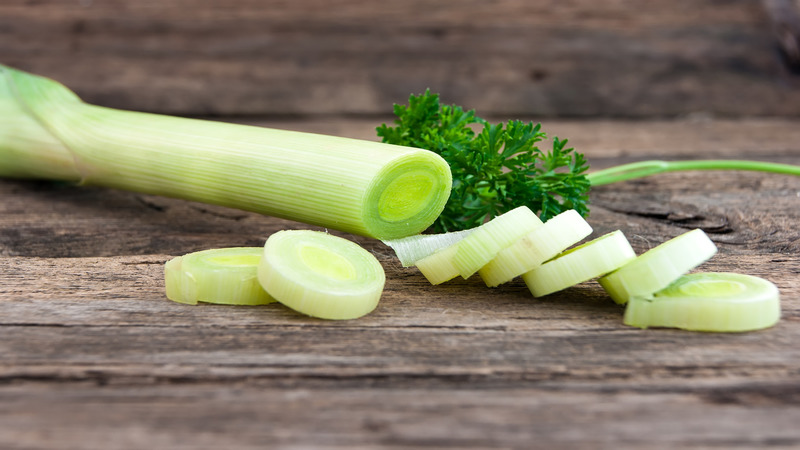
Regular consumption of vegetable crops is recommended for the treatment and prevention of the following diseases:
- pancreatitissince onions actively fight inflammatory processes;
- gastrointestinal problems, bloating, indigestion;
- gout and arthritis;
- rheumatism;
- hypertension;
- diabetes mellitus;
- tuberculosis;
- prostatitis;
- insomnia and depression;
- neoplasms.
How is it useful
Leeks have a beneficial effect on the body:
- strengthens the immune system;
- stimulates wound healing and skin cell regeneration;
- protects against infections;
- relieves stress and irritation.
For men
For the stronger sex, the vegetable provides essential assistance, maintaining a high level of efficiency and conserving energy. The bow will be especially useful for athletes and manual workers. The product allows men to stay strong, vigorous and not to feel tired for a long time.
The vegetable is used for the prevention and treatment of cardiovascular diseases, prostatitis and adenoma, and prostate cancer. Regular use of leeks will reduce the risk of developing these pathologies to a minimum. In addition, it enhances libido and has a positive effect on the reproductive system.
For women
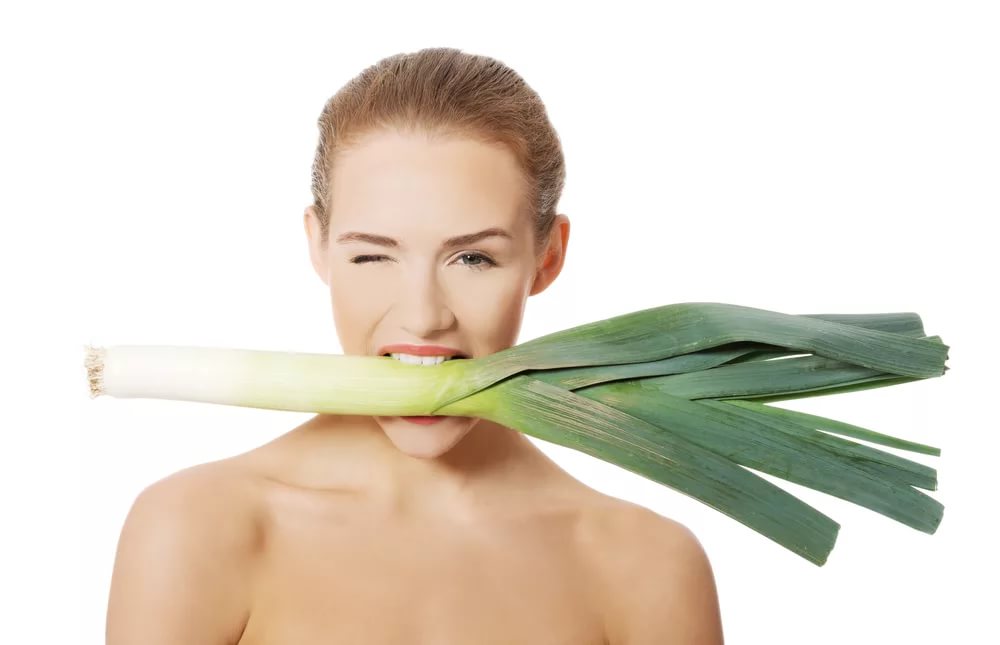
For women, leeks will help improve overall health, preserve beauty and youth.The rich vitamin and mineral composition of the product helps to restore strength and energy. The antioxidant properties of onions preserve the youth and elasticity of the skin. With regular use, the appearance of the hair improves - it becomes shiny, healthy and strong.
Leeks are especially recommended for women during pregnancy planning or while carrying a child. The substances that it is rich in, namely phosphorus, iron, magnesium, zinc and folic acid, are equally essential for the health of mothers and babies. In addition, the vegetable effectively protects against viruses and bacteria.
For kids
Leeks are among the healthy foods for a growing body. It is well absorbed and does not irritate the intestines. Boiled or chopped vegetables are allowed to be introduced into the children's diet from 7-8 months.
Leek contains macro- and microelements necessary for the proper development and growth of the baby. The vegetable improves memory and concentration, so it is recommended to include it in the diet of schoolchildren. It prevents colds, flu, runny nose and other illnesses in children.
Consumption rates per day
Leeks are good for human health. But the abuse of vegetables will adversely affect the state of the body or individual organs. Therefore, it is important to observe the daily norm: 100-200 g of raw vegetable for an adult. In the processed form, the dose is allowed to be slightly increased, since during heat treatment some of the nutrients are lost.
In what form is there, with what to combine
Any part of the vegetable is suitable for consumption, except for the roots. If the onion leaves are too tough, they are sent for cooking. soup or roast.
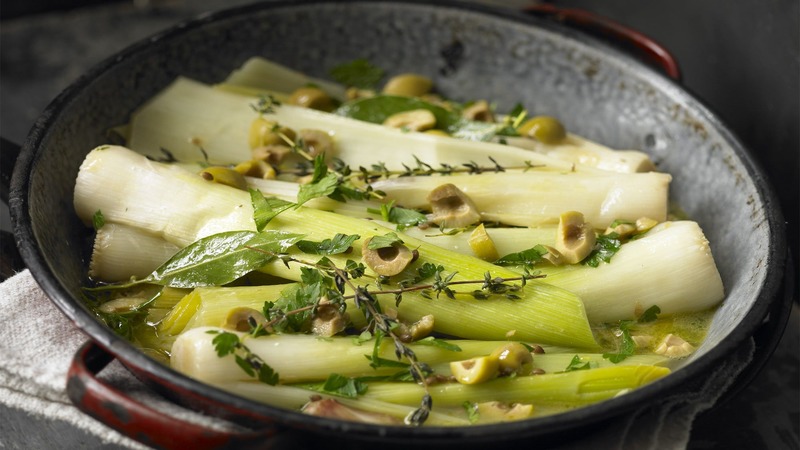
How to consume leeks:
- It is great for fresh consumption. It is eaten separately or as a bite with any dish. The best option is to add fresh vegetables to salads.
- Boiled onion leek is prepared as simply as possible. Place it in boiling and lightly salted water to cover the product (doesn't need a lot of liquid). Cut the onion into slices and cook for no more than 5-7 minutes. Then drain the water and dry it for 2-3 minutes in a pan.
- To cook steamed leek, wash it, cut it and place it in a steamer container or colander for no more than 15-29 minutes. The vegetable is salted only after removing from the steam.
- Roasted or grilled leek. The second option is more useful than the first. During frying, do not exceed the optimum temperature - + 90-130 ° C. To grill, brush all stems with ghee or vegetable oil.
- Add vegetable to stews or soups 5-7 minutes before removing from heat. Leeks are combined with any food - pasta, rice, potatoes, buckwheat.
Cooking applications
In cooking, the white part of leeks is used more often, since it is much softer and more tender in structure. The green part is also involved in cooking, but it is tougher, which means it takes longer to cook.
Green vegetable feathers are commonly added to soup and puree. They are also used if you want to dry onions.
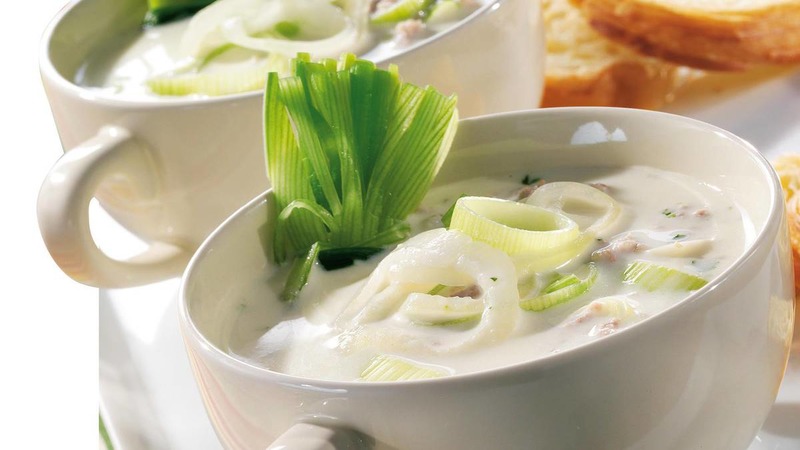
A large number of different dishes are prepared with the help of a vegetable. For instance:
- lecho;
- puree soup or onion soup;
- vegetable salad made from onions, tomatoes, cucumbers and bell peppers;
- pickled onions with mushrooms for the winter;
- garnish for meat or fish.
In folk medicine
The rich medicinal properties allow leeks to be used to treat various diseases. The most common problems that a vegetable can deal with effectively:
- Runny nose and colds... To do this, plant sap is instilled 3 times a day into each nostril.
- Angina and sore throat. Juice or fresh leek-based juice perfectly cope with painful sensations in the throat and eliminate suppuration.
- Pulmonary diseases. To speed up recovery from pneumonia or restore damaged tissues during the rehabilitation stage, traditional healers advise breathing over a boiled vegetable.
- Constipation. To eliminate this delicate problem, add at least one dish based on the gruel of the white leek to the diet.
Read also:
In cosmetology
On the basis of the miracle product, cosmetics are prepared that improve the condition of the skin and hair, prolong youth and fight the first signs of aging:
- moisturizing and nourishing creams;
- face masks;
- balms and shampoos for hair, and much more.
Leek products are especially effective in cleansing the skin. On its basis, harmless peels are made that remove a layer of dead skin cells from the epidermis.
It is recommended to rub onion gruel into hair roots to make them silky and get rid of dandruff, or into nails to strengthen them and prevent breakage.
Spot treatment with leaves of the affected skin will relieve acne, and grated fresh onion will eliminate age spots and freckles.
Slimming
Most nutritionists recommend including the vegetable in the diet due to its low calorie content. Onions normalize the digestive and metabolic processes in the body, remove excess fluid, harmful substances, toxins and slags.
Leek perfectly satiates, satisfies the feeling of hunger, which is especially important for people on strict diets. Moreover, the chromium in the vegetable reduces cravings for sweets.
Who is contraindicated
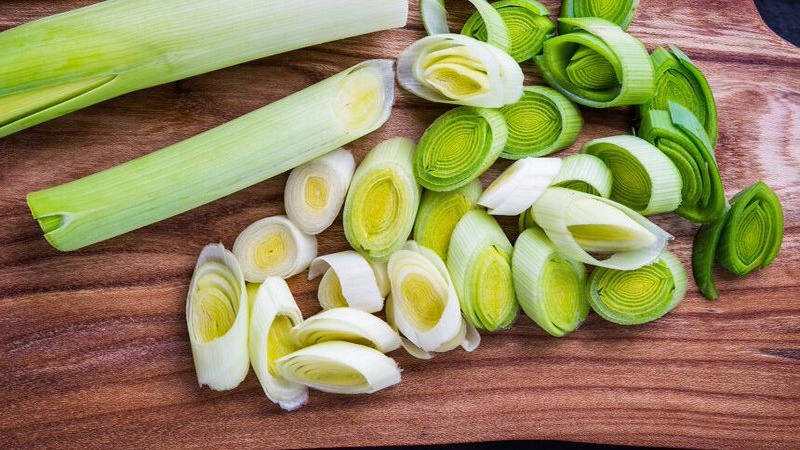
Sometimes leeks are not only beneficial but also harmful. The main contraindication to its use is inflammatory processes in the gastrointestinal tract. It is not recommended to eat leeks for people with high stomach acidity.
Refrain from eating leeks if:
- individual intolerance;
- exacerbation of urolithiasis - the pronounced diuretic effect of the product will harm the body if the kidneys are inflamed or cannot cope with their functions;
- diarrhea - onions aggravate the problem and additionally irritate the intestinal mucosa;
- breastfeeding - milk will acquire a special taste.
Reviews
Reviews on the use of leeks in the field of cosmetology and dietetics are positive.
Varvara, 29 years old:“It’s leeks that help me win weight. Its incredible taste conquered my family, and its low calorie content made it a favorite product. I often eat dietary leek soups, leek stews, and so on. The dishes are delicious, and most importantly, they help to get rid of extra pounds and keep the weight at the desired level. "
Christina, 24 years old: "To be honest, at first I was afraid to make masks with a bow for the face. But when you constantly suffer from skin problems, you have to make compromises. As a result, I got rid of acne and age spots in a month! "
Conclusion
Leeks have a positive effect both on individual systems and organs, and on the entire body. Its range of applications is not limited to cooking: it is used to treat diseases, in cosmetology and dietetics.
Leek is especially useful in the diet during the period of respiratory viral infections. It is also suitable for use by pregnant women. However, in all cases, remember that exceeding the daily allowance will be detrimental to health.